"Tadashi is here:" Grief and Loss of a Loved One in Big Hero 6
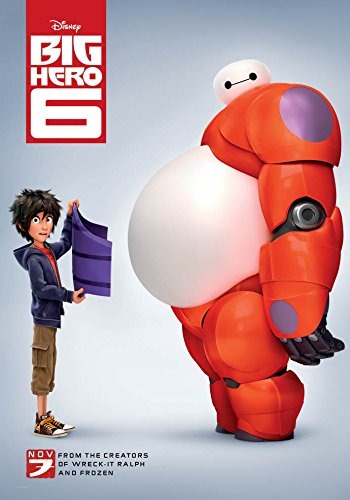
Big Hero 6, directed by Don Hall and Chris Williams, is an animated film that was released in the US on November 7, 2014. It was the first time that a Disney animated film adapted a Marvel Comics character to the big screen. It follows child robotic prodigy, Hiro Hamada as he goes after the man that stole his nanobot tech and is using them for evil. Hiro, along with his brother’s robot, Baymax, and his brother’s friends, form a superhero team to bring the man to justice. Although this animated film is for children, it tackles deep issues like depression, loss, and dealing with the death of a family member. The movie “challenges convention by giving younger viewers depictions of psychological damage. It makes visible what are otherwise invisible illnesses.” (Aranjuez 13).
I want to first give some background on Hiro and his brother Tadashi. I will basically be giving you a summary on everything that happened in the beginning of the movie. This way you’ll get a real good idea on why the loss of Tadashi affected Hiro. So, the film starts with Hiro going to an illegal bot fighting club. Eventually Hiro needs to be rescued after he hustles the current champion bot fighter, who does not respond well to that. Right before he gets beaten up, his older brother, Tadashi Hamada, comes to the rescue. Both of them get arrested and have to be bailed out by their Aunt Cass. This scene shows the tiny family that Hiro has (never going into what happened to their parents and why they live with their aunt), and how close they are to each other. Hiro is shown to be especially close to Tadashi since Tadashi constantly pushes Hiro to do more with his genius. Tadashi takes Hiro to his college, San Fransokyo Institute of Technology. This is where Hiro sees all the amazing robotic projects Tadashi’s friends have created. This is also where Hiro meets Tadashi’s robotic project, a personal healthcare robot called Baymax. He also got to meet the head of the robotic program, Professor Callaghan, who was a hero to Hiro. This inspires Hiro to apply to university. To get into the university, Hiro must create a new robotic project and present it at a showcase.
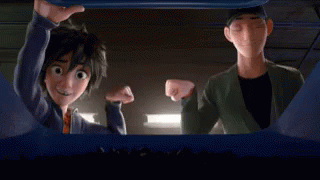
With the help of his brother, Tadashi gives Hiro the idea of creating nanobots. As he works on the project, Tadashi is constantly seen helping Hiro and encouraging him. The day of the showcase comes, and Hiro is overcome with nerves. So, Tadashi takes him aside and gives him a pep talk. Tadashi Hamada is only in the movie for about ten to fifteen minutes before he dies. Tadashi dies in his attempt to save Professor Callaghan from the burning university building. Yet, within that short amount of time, the audience falls in love with Tadashi, seeing how kind and caring of a person he was. And showing how much Tadashi really meant to Hiro. Which is why the audience was able to understand how Hiro fell into a depression after his death.
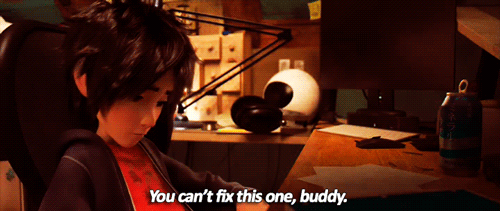
After Tadashi’s death, there is a montage showing what has happened since then. During it, Hiro is shown to not do anything after his death. Hiro doesn’t eat, doesn’t leave the house, or talk to any of his friends. He didn’t even sign up for classes after he was accepted into San Fransokyo Institute of Technology. At this point of the movie, Hiro is currently going through the five stages of grief over losing his older brothers. He starts off in the denial and depression stage, which is why he can’t bring himself to do anything. He does not do anything until he accidentally reactivates his brother’s robot, Baymax. After Baymax reactivates, Hiro ends up on a wild goose chase with Baymax. This is where Hiro discovers that the person who started the fire at the university stole Hiro’s microbots. Once Hiro and Baymax return home, Baymax asks about Tadashi, which leads to Hiro talking about Tadashi’s death.
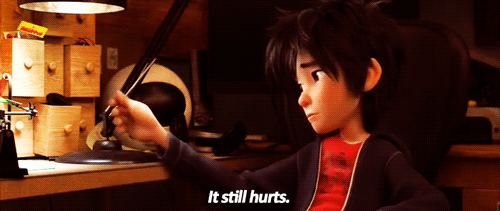
Hiro talks about being in pain over Tadashi’s death. Baymax, who is supposed to fix pain, does not quite understand. Hiro explains that it is an emotional hurt, which prompts Baymax to download all the information he can about emotionally hurts. He diagnoses what Hiro is going through as depression, and looks up all kinds of treatments for him, like contacting all his friends. It also shows us a comical scene of Baymax hugging Hiro and trying to make him feel better by patting his head. It’s one of my favorite scenes, so I felt the need to mention it. Baymax believes that he can help Hiro’s depression through these methods alone. However, Hiro believes that if he brings the man who started the fire to justice, he will feel better about Tadashi’s death. This shows that Hiro is in the bargaining stage of his grief, by bringing this man to justice he feels as though he can avenge his brother’s death, so he does not feel as though he died for nothing. This is where the whole superhero aspect is thrown into the film, which is a huge part, but we’re going to ignore that for the sake of this article.
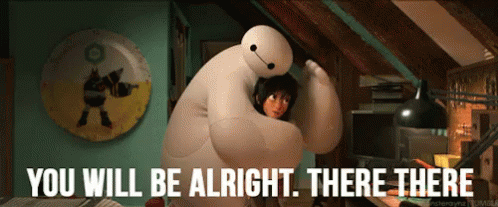
Going back to Hiro’s grief/mental health, the climax of the film pushes Hiro over the edge. At the climax, Hiro finds out who started the fire that killed his brother, and it was Professor Callaghan. Tadashi’s teacher and one of Hiro’s heroes. Hiro is devastated that Tadashi’s death was in vain since he went in to save Callaghan. In Hiro’s anger, he lashes out and orders Baymax to destroy Callaghan. When that doesn’t work and Baymax is damaged during the altercation, Hiro has him fly them home so he can fix Baymax. That whole scene portrays Hiro in the anger stage of his grief. He used Baymax to lash his anger out and continues to lash out in anger when Baymax does not do what he wants after Hiro fixes him.
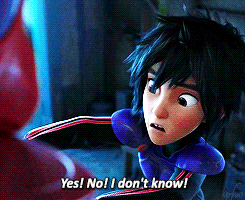
Hiro, after fixing Baymax’s scanner, tries to remove Baymax’s health code chip (the chip that Tadashi made and what makes Baymax a health care bot). If Hiro removes the chip, Baymax will go into attack mode and try to destroy Callaghan again. However, Baymax refuses to let Hiro get the chip and starts to ask Hiro questions. He asks if destroying Callaghan will make Hiro feel better, which leads to Hiro having a frantic response of uncertainty. This shows that Hiro is not thinking now, he is just reacting to his anger and letting it guide him. Eventually, Baymax asks if this is what Tadashi wants, which leads to Hiro exploding in anger and screaming that “Tadashi’s gone!” At this point, Hiro’s anger is gone, and he falls into Baymax’s chest.
After his anger is gone, Baymax says that “Tadashi is here,” and shows Hiro clips of Tadashi from when he first created Baymax. Seeing the videos of Tadashi made Hiro realize that even though Tadashi is gone physically, Tadashi is still with Hiro. This leads to Hiro finally coming to the last stage of grief, acceptance. Hiro accepts Tadashi’s death and can move on with his life. After everything in the movie is resolved with Callaghan, the audience gets to see that Hiro is talking to his friends and family again, going off to university, and keeping up his superhero business. They see Hiro moving on with his life and that the pain of losing a loved one is no longer holding him back.
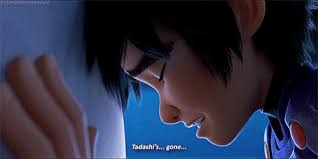
This film has everything that kids could love, superheroes, fight scenes, cool robots, but it also has things that kids can appreciate later in life. The movie shows that there are all kinds of pains that one can go through, not just physical pains. This validates the feelings that kids are going through and makes them understand that they are not alone in this. It also lets kids know that things will get better for them and encourages them to seek out help if they are feeling things like Hiro did. As someone who has experienced the same feelings that Hiro has gone through at a young age, I know if I saw this movie as a kid, I would feel as though my feelings were validated. This movie would have given me a feeling of hope and told me that this pain would pass eventually. Especially after the scene, “Tadashi is here.” That scene has my favorite quote from the whole movie:
I’m not giving up on you. You don’t understand this yet, but people need you. So let’s get back to work.
This quote perfectly describes Tadashi’s character and it’s a very hopeful quote for the audience. When he says it, the audience sees Tadashi talking directly to the camera, and it can be seen as Tadashi talking directly to them. As someone who has bad days, this quote still gives me hope that everything will be okay. This film teaches about what depression looks like in young children (and even adults), which is why it’s important because most children’s films won’t even go near the topic of depression. Big Hero 6 has shown that you can still tackle heavy topics, while still having a fun, unique film.
Work Cited
Aranjuez, Adolfo. “Power from a DIFFERENT PERSPECTIVE: Race, Gender and Grief in Big Hero 6.” Screen Education, no. 79, Australian Teachers of Media, Jan. 2015, pp. 8–15, http://search.proquest.com/docview/1784409977/.
Hall, Don and Williams, Chris, directors. Big Hero 6. Walt Disney Studios Motion Pictures, 2014.
MARJUNI, N. (2018, July 4). CHILDREN EMOTIONS IN BIG HERO 6 MOVIE. JURNAL LINER (Language Intelligence and Educational Research), 1(2), 65-88. Retrieved from http://journal.ipts.ac.id/index.php/LINER/article/view/366
0 Comments Add a Comment?